Pumping Station Desing - Second Edition by Robert L. Sanks, George Tchobahoglous, Garr M. Jones
Подождите немного. Документ загружается.

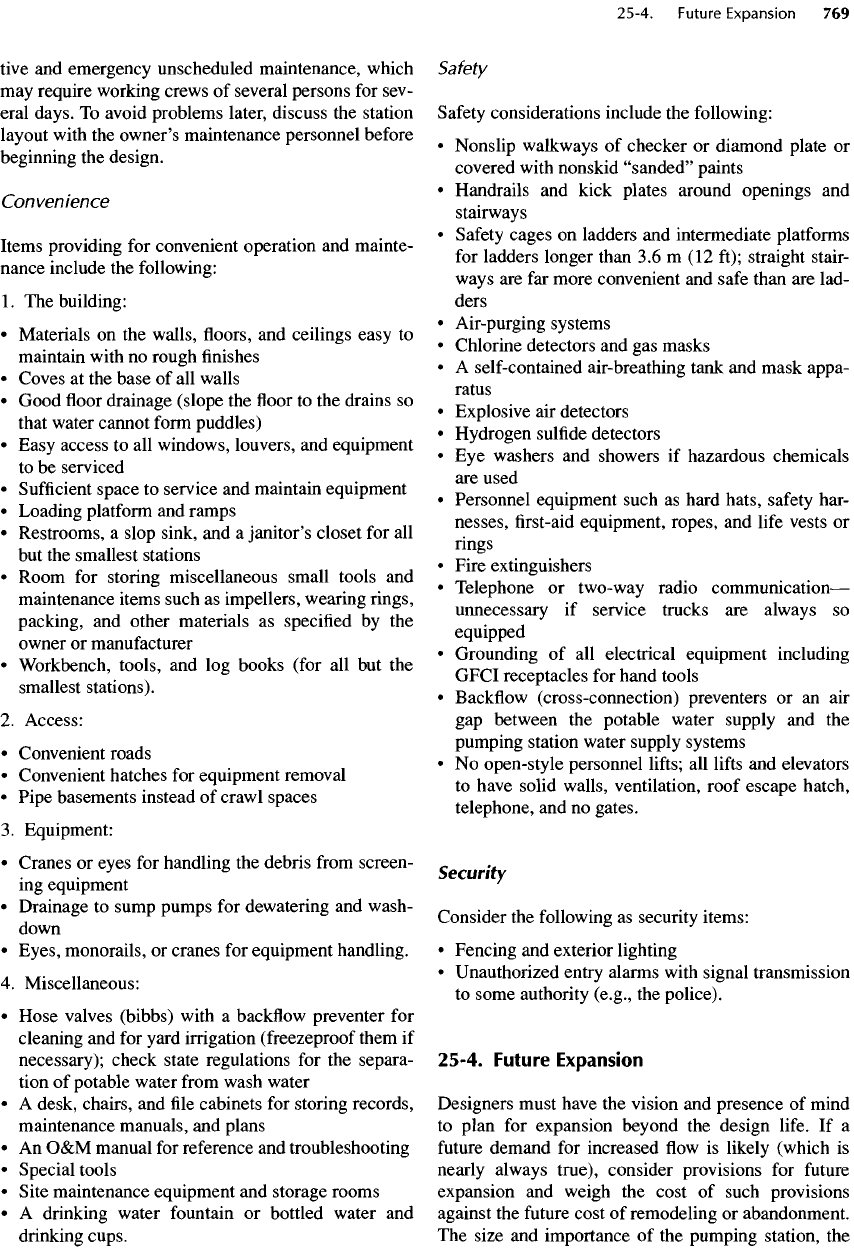
tive
and
emergency unscheduled maintenance, which
may
require working crews
of
several persons
for
sev-
eral days.
To
avoid problems later, discuss
the
station
layout
with
the
owner's maintenance personnel before
beginning
the
design.
Convenience
Items providing
for
convenient operation
and
mainte-
nance include
the
following:
1.
The
building:
•
Materials
on the
walls,
floors, and
ceilings easy
to
maintain with
no
rough finishes
•
Coves
at the
base
of all
walls
•
Good
floor
drainage (slope
the floor to the
drains
so
that
water cannot
form
puddles)
•
Easy access
to all
windows, louvers,
and
equipment
to
be
serviced
•
Sufficient
space
to
service
and
maintain equipment
•
Loading platform
and
ramps
•
Restrooms,
a
slop sink,
and a
janitor's
closet
for all
but
the
smallest stations
•
Room
for
storing miscellaneous small tools
and
maintenance items such
as
impellers,
wearing
rings,
packing,
and
other materials
as
specified
by the
owner
or
manufacturer
•
Workbench, tools,
and log
books (for
all but the
smallest
stations).
2.
Access:
•
Convenient roads
•
Convenient hatches
for
equipment removal
•
Pipe basements instead
of
crawl spaces
3.
Equipment:
•
Cranes
or
eyes
for
handling
the
debris
from
screen-
ing
equipment
•
Drainage
to
sump pumps
for
dewatering
and
wash-
down
•
Eyes, monorails,
or
cranes
for
equipment handling.
4.
Miscellaneous:
•
Hose valves (bibbs) with
a
backflow
preventer
for
cleaning
and for
yard irrigation
(freezeproof
them
if
necessary); check state regulations
for the
separa-
tion
of
potable water
from
wash water
• A
desk, chairs,
and file
cabinets
for
storing records,
maintenance
manuals,
and
plans
• An O&M
manual
for
reference
and
troubleshooting
•
Special tools
•
Site maintenance equipment
and
storage rooms
• A
drinking water
fountain
or
bottled water
and
drinking cups.
Safety
Safety
considerations include
the
following:
•
Nonslip walkways
of
checker
or
diamond plate
or
covered with nonskid
"sanded"
paints
•
Handrails
and
kick plates around openings
and
stairways
•
Safety
cages
on
ladders
and
intermediate platforms
for
ladders longer than
3.6 m (12
ft); straight stair-
ways
are far
more convenient
and
safe
than
are
lad-
ders
•
Air-purging systems
•
Chlorine detectors
and gas
masks
• A
self-contained air-breathing tank
and
mask appa-
ratus
•
Explosive
air
detectors
•
Hydrogen
sulfide
detectors
• Eye
washers
and
showers
if
hazardous chemicals
are
used
•
Personnel equipment such
as
hard hats,
safety
har-
nesses,
first-aid
equipment, ropes,
and
life
vests
or
rings
•
Fire
extinguishers
•
Telephone
or
two-way radio
communication
—
unnecessary
if
service trucks
are
always
so
equipped
•
Grounding
of all
electrical
equipment including
GFCI receptacles
for
hand tools
•
Backflow
(cross-connection) preventers
or an air
gap
between
the
potable water supply
and the
pumping
station water supply systems
• No
open-
sty
Ie
personnel
lifts;
all
lifts
and
elevators
to
have solid walls, ventilation, roof escape hatch,
telephone,
and no
gates.
Security
Consider
the
following
as
security items:
•
Fencing
and
exterior lighting
•
Unauthorized entry alarms with signal transmission
to
some authority (e.g.,
the
police).
25-4.
Future
Expansion
Designers must have
the
vision
and
presence
of
mind
to
plan
for
expansion beyond
the
design
life.
If a
future
demand
for
increased
flow is
likely (which
is
nearly
always true), consider provisions
for
future
expansion
and
weigh
the
cost
of
such provisions
against
the
future
cost
of
remodeling
or
abandonment.
The
size
and
importance
of the
pumping station,
the

owner's requirements,
and the
uncertainties
of
need,
time
lapse,
and
expected
flow
increase must
be
taken
as
intangible
but
essential
and
sometimes overriding
considerations.
The
method
for
achieving
the
future
increase
in
capacity
should
be
included
in the
specifications
and
the
plans. Future expansion
can be
facilitated
in a
number
of
ways
that include:
•
Pumps with medium-sized impellers that
can be
changed
for
larger ones
•
Generous space
for
each pump
so
that
a
larger
pump
can be
installed;
the
extra space will
be
appreciated
by the
maintenance
staff
•
Suction
and
discharge piping large enough
to
per-
mit
the
increased
flow
•
Space
for
additional pumps; terminate suction pip-
ing
and
pipe connections
to the
header with valves
and
blind
flanges
•
Provision
for
enlarging
the
building
by
adding steel
waterstops
and
dowels
for
connecting
future
walls
and
floors;
bend
the
dowels
to the
face
of the
con-
crete
and
protect exposed steel with lean mortar
(note
that rubber
or
plastic waterstops
can be too
easily
damaged
by
future
construction)
• An
electrical system designed
so
that
the
entire sys-
tem
will
not
have
to be
rebuilt;
use
larger conduit,
for
example,
and
leave extra space where
needed.
Plan
the
operations necessary
to
allow
the
changes
to
be
made while
the
station remains
in
operation.
Consider
the
following:
• The
pump manufacturer should know whether
larger impellers
are to be
used
so
that bearing
frames,
bearings, motor,
and
other
associated
parts
are
sized
properly.
• The
removal
of
blind
flanges on the
discharge side
of
a
future
pump requires either
(1) a
means
for
quickly
draining pressurized pipelines
or (2) a
valve
at
the flange.
Note that valves
are
likely
to
become
inoperative unless regularly exercised. Gate valves
are the
worst, lubricated plug valves
are
good (and
the
most expensive),
and
stop plates
or
slide gates
are
the
best,
the
most reliable,
and the
least expen-
sive
when they
can be
used
for
isolating pump inlets.
• The
removal
of
blind
flanges on
suction
pipes
requires
dewatering
the wet
well
(or a
portion
thereof)
in a way
that minimizes
(or
eliminates)
downtime
or
prevents
overflows
in
wastewater
pumping stations.
The wet
well
may be
compart-
mentalized
by
inserting stop plates into grooves
provided
for
that purpose.
•
Considerable storage
is
available
in
sewers
upstream
from
most wastewater pumping sta-
tions
—
storage
that
is
sufficient
to
make
the
needed
connections
if
planned properly
and
executed
at the
lowest flow.
•
Because blind
flanges are
heavy, provide
lifting
handles
to
speed removal.
•
Ensure convenience
for the
lifting
equipment needed
to
install
new or
replacement facilities,
and
provide
access
for the
installation
of new
equipment.
The
capacity
of an
existing pumping station
can
often
be
increased.
To
avoid blunders,
first
make
field
measurements
of flow,
static head,
friction
head, true
pipe diameter,
and
roughness
coefficient.
Trust
no
plans
—
not
even record drawings. Measure
the
station,
especially
the
piping
connections,
so
that
the new
facilities
will
fit
exactly. Various methods
of
increas-
ing
the
capacity
are
•
Cleaning
and
relining transmission pipelines
in
place
•
Laying
new
transmission lines
or
force mains
•
Substituting larger impellers
in
existing pumps
•
Substituting larger pumps
and
motors
if the
suction
and
discharge piping permits
•
Adding submersible pumps
in the
existing
wet
well
•
Converting
the dry
well
to a wet
well
and
adding
submersible
or
VTSH pumps
•
Adding
a new wet
well with submersible pumps
•
Constructing
a new
pumping station
•
Adding
a
booster pumping station.
25-5.
Hydraulic
Constraints
The
hydraulic constraints include
the flow
capacity
(and
the
range
of
capacities),
the
discharge character-
istics
required
of the
pumps (the
range
of
both
the
flow
and
the
head),
the
suction head,
and the
type
of
fluid
pumped.
Wastewater
Pumping
Pumping stations should
be
designed
to
handle
flows
from
the
entire service area. Obtain owner input
regarding
the
size
of the
service area. Install
a
pump-
ing
capacity that
is
adequate
for the
fully
developed
service
area,
or
install
a
pumping
and
force main
capacity that
can
handle both
the
current needs
and
those
of the
immediate
future
with
an
adequate provi-
sion
for
economically adding
to the
capacity
in the
future.
Consider both average
and
peak
flows,
which
may
be
based
on (1)
existing
and
future
land use,
(2)
per
capita
flow
estimates,
or (3)
actual
field flowrate
measurements. Consult
the
literature before making
flow
projections
[1-5].
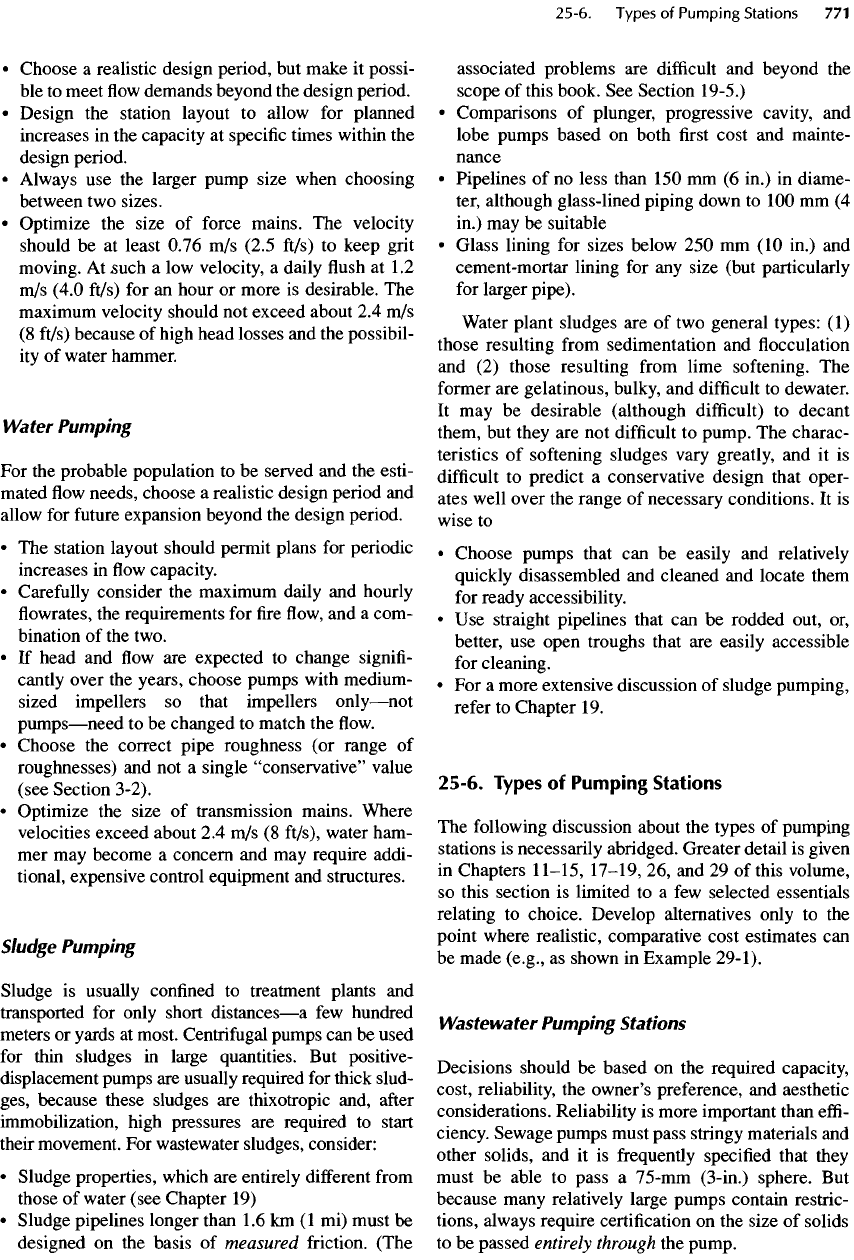
•
Choose
a
realistic
design period,
but
make
it
possi-
ble
to
meet
flow
demands beyond
the
design period.
•
Design
the
station layout
to
allow
for
planned
increases
in the
capacity
at
specific times within
the
design period.
•
Always
use the
larger pump size when choosing
between
two
sizes.
•
Optimize
the
size
of
force mains.
The
velocity
should
be at
least
0.76
m/s
(2.5
ft/s)
to
keep grit
moving.
At
such
a low
velocity,
a
daily
flush at
1
.2
m/s
(4.0
ft/s)
for an
hour
or
more
is
desirable.
The
maximum
velocity should
not
exceed about
2.4 m/s
(8
ft/s) because
of
high head losses
and the
possibil-
ity
of
water hammer.
Water
Pumping
For the
probable population
to be
served
and the
esti-
mated
flow
needs, choose
a
realistic design period
and
allow
for
future
expansion beyond
the
design period.
• The
station layout should permit plans
for
periodic
increases
in flow
capacity.
•
Carefully
consider
the
maximum daily
and
hourly
flowrates,
the
requirements
for fire flow, and a
com-
bination
of the
two.
• If
head
and flow are
expected
to
change
signifi-
cantly
over
the
years, choose pumps with medium-
sized
impellers
so
that impellers
only
—
not
pumps
—
need
to be
changed
to
match
the flow.
•
Choose
the
correct
pipe
roughness
(or
range
of
roughnesses)
and not a
single "conservative" value
(see Section
3-2).
•
Optimize
the
size
of
transmission mains. Where
velocities exceed about
2.4 m/s (8
ft/s),
water ham-
mer
may
become
a
concern
and may
require addi-
tional, expensive control equipment
and
structures.
Sludge
Pumping
Sludge
is
usually
confined
to
treatment plants
and
transported
for
only short
distances
—
a
few
hundred
meters
or
yards
at
most.
Centrifugal
pumps
can be
used
for
thin sludges
in
large quantities.
But
positive-
displacement pumps
are
usually required
for
thick slud-
ges, because these sludges
are
thixotropic
and,
after
immobilization, high pressures
are
required
to
start
their movement.
For
wastewater sludges, consider:
•
Sludge properties, which
are
entirely
different
from
those
of
water
(see
Chapter
19)
•
Sludge pipelines longer than
1.6 km (1 mi)
must
be
designed
on the
basis
of
measured friction.
(The
associated problems
are
difficult
and
beyond
the
scope
of
this book.
See
Section 19-5.)
•
Comparisons
of
plunger, progressive cavity,
and
lobe pumps based
on
both
first
cost
and
mainte-
nance
•
Pipelines
of no
less than
150 mm (6
in.)
in
diame-
ter,
although glass-lined piping down
to 100 mm (4
in.)
may be
suitable
•
Glass lining
for
sizes below
250 mm (10
in.)
and
cement-mortar lining
for any
size
(but
particularly
for
larger pipe).
Water
plant sludges
are of two
general types:
(1)
those resulting
from
sedimentation
and flocculation
and
(2)
those resulting
from
lime softening.
The
former
are
gelatinous, bulky,
and
difficult
to
dewater.
It may be
desirable (although
difficult)
to
decant
them,
but
they
are not
difficult
to
pump.
The
charac-
teristics
of
softening sludges vary greatly,
and it is
difficult
to
predict
a
conservative design that oper-
ates well over
the
range
of
necessary conditions.
It is
wise
to
•
Choose pumps that
can be
easily
and
relatively
quickly
disassembled
and
cleaned
and
locate them
for
ready accessibility.
• Use
straight
pipelines
that
can be
rodded
out,
or,
better,
use
open troughs that
are
easily accessible
for
cleaning.
• For a
more extensive discussion
of
sludge pumping,
refer
to
Chapter
19.
25-6.
Types
of
Pumping
Stations
The
following discussion about
the
types
of
pumping
stations
is
necessarily abridged. Greater detail
is
given
in
Chapters
11-15,
17-19,
26, and 29 of
this volume,
so
this section
is
limited
to a few
selected
essentials
relating
to
choice. Develop alternatives only
to the
point where realistic, comparative cost estimates
can
be
made (e.g.,
as
shown
in
Example
29-1).
Wastewater
Pumping
Stations
Decisions should
be
based
on the
required capacity,
cost, reliability,
the
owner's preference,
and
aesthetic
considerations. Reliability
is
more important than
effi-
ciency. Sewage pumps must pass stringy materials
and
other
solids,
and it is
frequently specified that they
must
be
able
to
pass
a
75-mm (3-in.) sphere.
But
because many relatively large pumps contain restric-
tions, always require certification
on the
size
of
solids
to be
passed
entirely
through
the
pump.
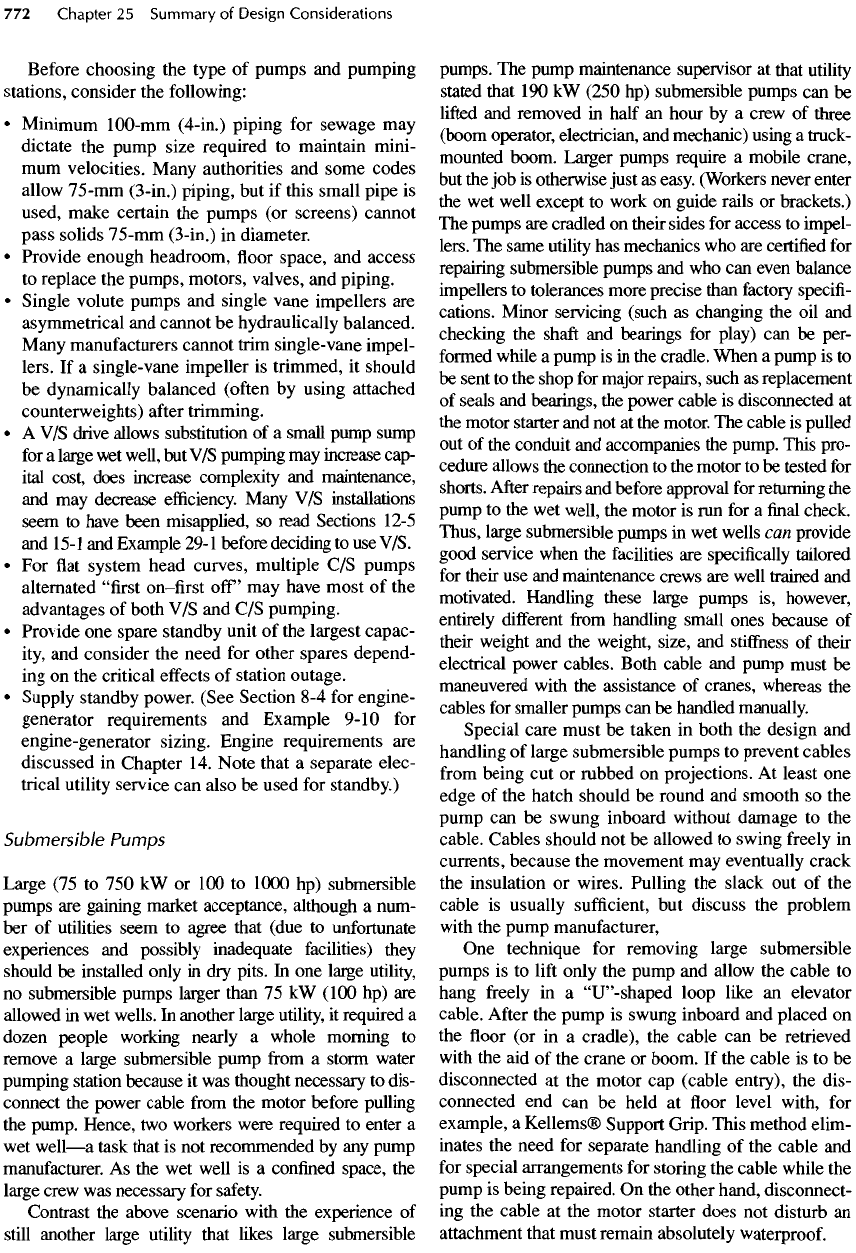
Before
choosing
the
type
of
pumps
and
pumping
stations, consider
the
following:
•
Minimum
100-mm
(4-in.) piping
for
sewage
may
dictate
the
pump size required
to
maintain mini-
mum
velocities. Many authorities
and
some codes
allow
75-mm
(3-in.) piping,
but if
this small
pipe
is
used, make certain
the
pumps
(or
screens) cannot
pass solids 75-mm (3-in.)
in
diameter.
•
Provide enough headroom,
floor
space,
and
access
to
replace
the
pumps, motors, valves,
and
piping.
•
Single volute pumps
and
single vane impellers
are
asymmetrical
and
cannot
be
hydraulically
balanced.
Many
manufacturers cannot trim single-vane impel-
lers.
If a
single-vane impeller
is
trimmed,
it
should
be
dynamically balanced
(often
by
using attached
counterweights)
after
trimming.
• A V/S
drive allows substitution
of a
small pump sump
for
a
large
wet
well,
but V/S
pumping
may
increase cap-
ital
cost, does increase complexity
and
maintenance,
and
may
decrease
efficiency.
Many
V/S
installations
seem
to
have
been misapplied,
so
read Sections
12-5
and
15-1
and
Example
29-1
before
deciding
to use
V/S.
• For flat
system head curves, multiple
C/S
pumps
alternated
"first
on-first
off'
may
have most
of the
advantages
of
both
V/S and C/S
pumping.
•
Provide
one
spare standby unit
of the
largest capac-
ity,
and
consider
the
need
for
other spares depend-
ing on the
critical
effects
of
station outage.
•
Supply standby power.
(See
Section
8-4 for
engine-
generator requirements
and
Example
9-10
for
engine-generator sizing. Engine requirements
are
discussed
in
Chapter
14.
Note that
a
separate elec-
trical
utility
service
can
also
be
used
for
standby.)
Submersible
Pumps
Large
(75 to 750 kW or 100 to
1000
hp)
submersible
pumps
are
gaining market acceptance, although
a
num-
ber of
utilities seem
to
agree that
(due
to
unfortunate
experiences
and
possibly inadequate facilities) they
should
be
installed only
in dry
pits.
In one
large utility,
no
submersible pumps larger than
75 kW
(100
hp) are
allowed
in wet
wells.
In
another large utility,
it
required
a
dozen
people working nearly
a
whole morning
to
remove
a
large submersible pump
from
a
storm water
pumping
station because
it was
thought necessary
to
dis-
connect
the
power cable
from
the
motor before pulling
the
pump. Hence,
two
workers were required
to
enter
a
wet
well
—
a
task that
is not
recommended
by any
pump
manufacturer.
As the wet
well
is a
confined
space,
the
large crew
was
necessary
for
safety.
Contrast
the
above scenario with
the
experience
of
still
another large utility that likes large submersible
pumps.
The
pump maintenance supervisor
at
that utility
stated that
190 kW
(250
hp)
submersible pumps
can be
lifted
and
removed
in
half
an
hour
by a
crew
of
three
(boom operator, electrician,
and
mechanic) using
a
truck-
mounted
boom. Larger pumps require
a
mobile crane,
but
the job is
otherwise just
as
easy. (Workers never enter
the wet
well except
to
work
on
guide rails
or
brackets.)
The
pumps
are
cradled
on
their sides
for
access
to
impel-
lers.
The
same utility
has
mechanics
who are
certified
for
repairing submersible pumps
and who can
even balance
impellers
to
tolerances more
precise
than
factory
specifi-
cations. Minor servicing (such
as
changing
the oil and
checking
the
shaft
and
bearings
for
play)
can be
per-
formed
while
a
pump
is in the
cradle. When
a
pump
is to
be
sent
to the
shop
for
major
repairs, such
as
replacement
of
seals
and
bearings,
the
power cable
is
disconnected
at
the
motor starter
and not at the
motor.
The
cable
is
pulled
out
of the
conduit
and
accompanies
the
pump. This
pro-
cedure allows
the
connection
to the
motor
to be
tested
for
shorts.
After
repairs
and
before approval
for
returning
the
pump
to the wet
well,
the
motor
is run for a final
check.
Thus, large submersible pumps
in wet
wells
can
provide
good service when
the
facilities
are
specifically tailored
for
their
use and
maintenance crews
are
well trained
and
motivated. Handling these large pumps
is,
however,
entirely
different
from
handling small ones because
of
their weight
and the
weight, size,
and
stiflhess
of
their
electrical power cables. Both cable
and
pump must
be
maneuvered
with
the
assistance
of
cranes, whereas
the
cables
for
smaller pumps
can be
handled manually.
Special care must
be
taken
in
both
the
design
and
handling
of
large submersible pumps
to
prevent cables
from
being
cut or
rubbed
on
projections.
At
least
one
edge
of the
hatch should
be
round
and
smooth
so the
pump
can be
swung inboard without damage
to the
cable.
Cables
should
not be
allowed
to
swing
freely
in
currents, because
the
movement
may
eventually crack
the
insulation
or
wires. Pulling
the
slack
out of the
cable
is
usually
sufficient,
but
discuss
the
problem
with
the
pump manufacturer,
One
technique
for
removing large submersible
pumps
is to
lift
only
the
pump
and
allow
the
cable
to
hang
freely
in a
"!!"-shaped
loop like
an
elevator
cable.
After
the
pump
is
swung inboard
and
placed
on
the
floor (or in a
cradle),
the
cable
can be
retrieved
with
the aid of the
crane
or
boom.
If the
cable
is to be
disconnected
at the
motor
cap
(cable entry),
the
dis-
connected
end can be
held
at floor
level with,
for
example,
a
Kellems® Support Grip. This method elim-
inates
the
need
for
separate handling
of the
cable
and
for
special arrangements
for
storing
the
cable while
the
pump
is
being
repaired.
On the
other
hand,
disconnect-
ing
the
cable
at the
motor starter does
not
disturb
an
attachment that must remain absolutely
waterproof.
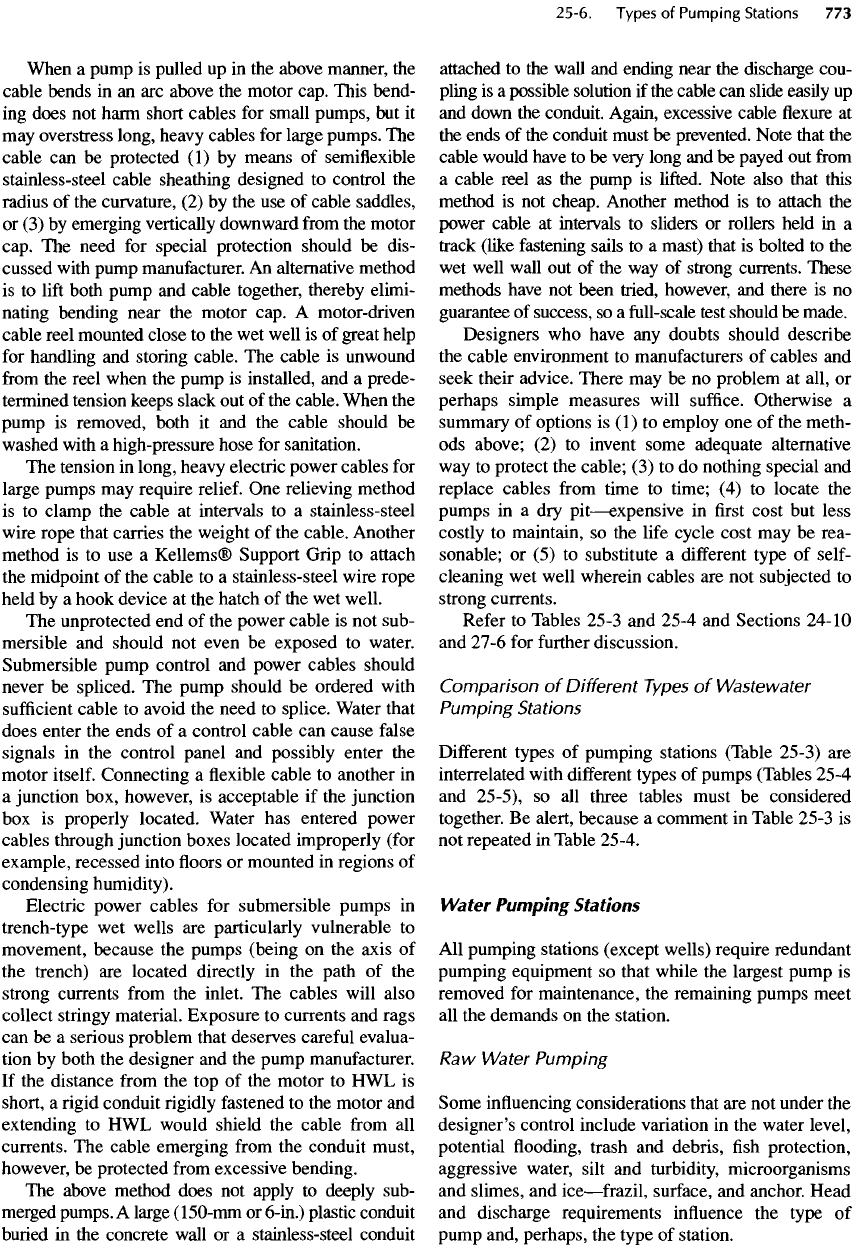
When
a
pump
is
pulled
up in the
above manner,
the
cable bends
in an arc
above
the
motor cap. This bend-
ing
does
not
harm short cables
for
small pumps,
but it
may
overstress long, heavy cables
for
large pumps.
The
cable
can be
protected
(1) by
means
of
semiflexible
stainless-steel cable sheathing designed
to
control
the
radius
of the
curvature,
(2) by the use of
cable saddles,
or (3) by
emerging vertically downward
from
the
motor
cap.
The
need
for
special protection should
be
dis-
cussed with pump manufacturer.
An
alternative method
is
to
lift
both pump
and
cable together, thereby elimi-
nating
bending near
the
motor cap.
A
motor-driven
cable
reel
mounted close
to the wet
well
is of
great help
for
handling
and
storing cable.
The
cable
is
unwound
from
the
reel when
the
pump
is
installed,
and a
prede-
termined tension keeps slack
out of the
cable.
When
the
pump
is
removed, both
it and the
cable should
be
washed
with
a
high-pressure hose
for
sanitation.
The
tension
in
long, heavy
electric
power
cables
for
large pumps
may
require relief.
One
relieving method
is
to
clamp
the
cable
at
intervals
to a
stainless-steel
wire rope that
carries
the
weight
of the
cable. Another
method
is to use a
Kellems® Support Grip
to
attach
the
midpoint
of the
cable
to a
stainless-steel wire rope
held
by a
hook device
at the
hatch
of the wet
well.
The
unprotected
end of the
power cable
is not
sub-
mersible
and
should
not
even
be
exposed
to
water.
Submersible pump control
and
power cables should
never
be
spliced.
The
pump should
be
ordered with
sufficient
cable
to
avoid
the
need
to
splice.
Water that
does enter
the
ends
of a
control cable
can
cause
false
signals
in the
control panel
and
possibly enter
the
motor itself. Connecting
a flexible
cable
to
another
in
a
junction box, however,
is
acceptable
if the
junction
box
is
properly located. Water
has
entered power
cables through junction boxes located improperly (for
example, recessed into
floors or
mounted
in
regions
of
condensing humidity).
Electric power cables
for
submersible pumps
in
trench-type
wet
wells
are
particularly vulnerable
to
movement, because
the
pumps (being
on the
axis
of
the
trench)
are
located directly
in the
path
of the
strong currents
from
the
inlet.
The
cables will also
collect
stringy material. Exposure
to
currents
and
rags
can
be a
serious problem that deserves
careful
evalua-
tion
by
both
the
designer
and the
pump manufacturer.
If
the
distance
from
the top of the
motor
to HWL is
short,
a
rigid conduit
rigidly
fastened
to the
motor
and
extending
to HWL
would shield
the
cable
from
all
currents.
The
cable emerging
from
the
conduit must,
however,
be
protected
from
excessive bending.
The
above method does
not
apply
to
deeply sub-
merged
pumps.
A
large
(150-mm
or
6-in.)
plastic conduit
buried
in the
concrete
wall
or a
stainless-steel conduit
attached
to the
wall
and
ending near
the
discharge cou-
pling
is a
possible
solution
if the
cable
can
slide easily
up
and
down
the
conduit. Again, excessive cable
flexure at
the
ends
of the
conduit must
be
prevented. Note that
the
cable would have
to be
very long
and be
payed
out from
a
cable reel
as the
pump
is
lifted.
Note also
that
this
method
is not
cheap. Another method
is to
attach
the
power cable
at
intervals
to
sliders
or
rollers held
in a
track
(like fastening sails
to a
mast) that
is
bolted
to the
wet
well wall
out of the way of
strong currents. These
methods have
not
been tried, however,
and
there
is no
guarantee
of
success,
so a
full-scale
test should
be
made.
Designers
who
have
any
doubts should describe
the
cable environment
to
manufacturers
of
cables
and
seek their advice. There
may be no
problem
at
all,
or
perhaps simple measures will
suffice.
Otherwise
a
summary
of
options
is (1) to
employ
one of the
meth-
ods
above;
(2) to
invent some adequate alternative
way
to
protect
the
cable;
(3) to do
nothing
special
and
replace
cables
from
time
to
time;
(4) to
locate
the
pumps
in a dry
pit
—
expensive
in first
cost
but
less
costly
to
maintain,
so the
life
cycle
cost
may be
rea-
sonable;
or (5) to
substitute
a
different
type
of
self-
cleaning
wet
well wherein cables
are not
subjected
to
strong currents.
Refer
to
Tables 25-3
and
25-4
and
Sections 24-10
and
27-6
for
further
discussion.
Comparison
of
Different Types
of
Wastewater
Pumping
Stations
Different
types
of
pumping stations (Table 25-3)
are
interrelated with
different
types
of
pumps (Tables 25-4
and
25-5),
so all
three tables must
be
considered
together.
Be
alert, because
a
comment
in
Table 25-3
is
not
repeated
in
Table 25-4.
Water
Pumping
Stations
All
pumping stations (except wells) require redundant
pumping
equipment
so
that while
the
largest pump
is
removed
for
maintenance,
the
remaining pumps meet
all the
demands
on the
station.
Raw
Water
Pumping
Some
influencing
considerations that
are not
under
the
designer's control include variation
in the
water level,
potential
flooding,
trash
and
debris,
fish
protection,
aggressive water, silt
and
turbidity, microorganisms
and
slimes,
and
ice
—
frazil,
surface,
and
anchor. Head
and
discharge requirements
influence
the
type
of
pump
and, perhaps,
the
type
of
station.

Table 25-3.
Comparison
of
Wastewater
Pumping
Station Types
Advantages
Disadvantages
Dry
well-wet
well
Easy access
for
maintenance.
Wider range
of
head
and
capacity.
Wider choice
of
driver arrangements.
Possible
to use flood-protected
motors.
Flooded suction improves reliability.
With long
shaft
and flood-protected
motors
at
grade, electrical
leads
are
short.
Greater
cost
due to
excavation
and
building below
grade
—
expensive
if
groundwater
is
high,
if
soils
are
very poor,
or if
blasting
is
required.
Greater risk
of
outage
due to flooding; dry
well must
be
kept dry.
Flood-protected motors
(in the dry
well)
are
expensive.
Long leads
to the
motor
(in the dry
well)
from
the
control panel
if
the
motors
are
frame-mounted
to the
pumps.
Wet
well
pumps
with
above-grade
drivers
Less excavation (eliminates
the dry
well).
Small superstructure.
Above-grade drivers protected
from
flooding.
Difficult
to
remove
for
servicing, especially
the
pumps with
separate discharge
pipe.
Difficult
to
service
in
place,
wet
well must
be
drained
or
pump
removed
for
major disassembly
to
reach many parts.
High superstructure needed
to
permit
the
removal
of the
pump.
Submerged bearings
are
subject
to
overloads
and
frequent
failures.
Difficult
to
keep lubricated
and
protected
from
grit.
Should
not be
used
in raw
sewage (clogging) applications.
Wet
well with self-priming
pumps
above
grade
Least construction cost, easiest maintenance.
Convenient access
to
pumps above ground.
Eliminates
dry
well.
No
flood
hazard
to
motors.
Self
-priming
pumps
do not
have trimmable
impellers,
so
they
are
usually
belt driven
to
reach
the
design point.
Belt
drives
are
easily changed
to
meet
a new
condition point,
but
V-belts
require proper
adjustment
and
periodic replacement.
Reduced reliability
due to the
need
for
priming.
Distance
from
the low wet
well level
to the
pumps
is
limited
by
NPSH
and the
priming system
to
about
8 m (25
ft).
If
operated infrequently, putrefaction with
gas
production
can
occur
to
break
prime
and/or
to
make sewage
boil
at
6O
0
C
(14O
0
F),
so an
external priming system must then
be
used.
Wet
well
submersible
pumps
and
motors
No
dry
well; excavation
and
concrete reduced.
No
superstructure required except
for
engine-generator
or
cabinet
for
motor controls.
No
seal water system,
no
long
shafts
with steady bearings
required.
Reduces
the
land area needed.
All
of the
above reduces construction costs (see Figure 29-9).
Quick removal
and
replacement
in
emergencies.
Well
adapted
for
increasing
the
capacity
of a
pumping station
using
existing
wet and dry
wells.
No
daily
nor
weekly maintenance (but overhaul needed every
1 to 5
yr).
Units
removable
for
shop servicing, minimizes
field
work.
Quiet operation.
Safety
from
flooding.
On
a
life-cycle basis, balance
the
lower
first
cost
of
submersible
pumping
station with
its
lack
of
regular,
frequent
maintenance
chores against
the
cost
of
complete overhauls
by
specially trained mechanics
(or at
manufacturer's service
center).
Elimination
of (1) the dry
well,
(2)
frequent
preventive
maintenance,
and (3) the
seal water systems that, coupled
with
simpler design
and low first
cost, lead some engineers
and
many operators
to
prefer submersible pumps.
Valves
and
headers must
be
accessible
(1)
in an
adjacent
vault,
(2)
in a
small above-grade superstructure,
or (3) by
exposing
the
header above grade.
Pump must
be
removed
and
disassembled
for
inspection
and
maintenance. Requires
a
hoist
or
crane
and
specially trained
mechanics
Hazard
of
pumps jamming
on
guide rails
or not
seating properly.
Often
more
difficult
to
remove pumps than manufacturers admit.
Pumps larger than
75 kW
(100
hp)
especially
difficult
to
handle
(see text above).
Special motors, seals,
and
moisture monitoring required (but
moisture probes
are
useless
for
leaks
via
power cable).
Makes
differ
greatly with respect
to
satisfactory performance,
and
quality
of
pump/driver unit
has a
very
high impact
on
maintenance
and
life-cycle cost.
Vibration
has
occurred with some makes
of
pumps larger than
22
kW (30
hp).
Guarantees
often
are
valid only
if
repairs
are
made
by
authorized
service
centers.
At
least
one
uninstalled
spare unit
(in
addition
to
standby units)
in
each size
is
needed
to
permit shop servicing, which adds
to
the
cost trade-off
for
submersibles.
Pumps
and
motors
are
generally
not
suited mechanically
for V/S
operation (although AFDs
can be
used).
Inaccessibility
of the
pump
and
motor
for
routine preventive
maintenance
and the
need
for
occasional
expensive overhauls
lead some engineers
to
refuse
to
countenance their use.
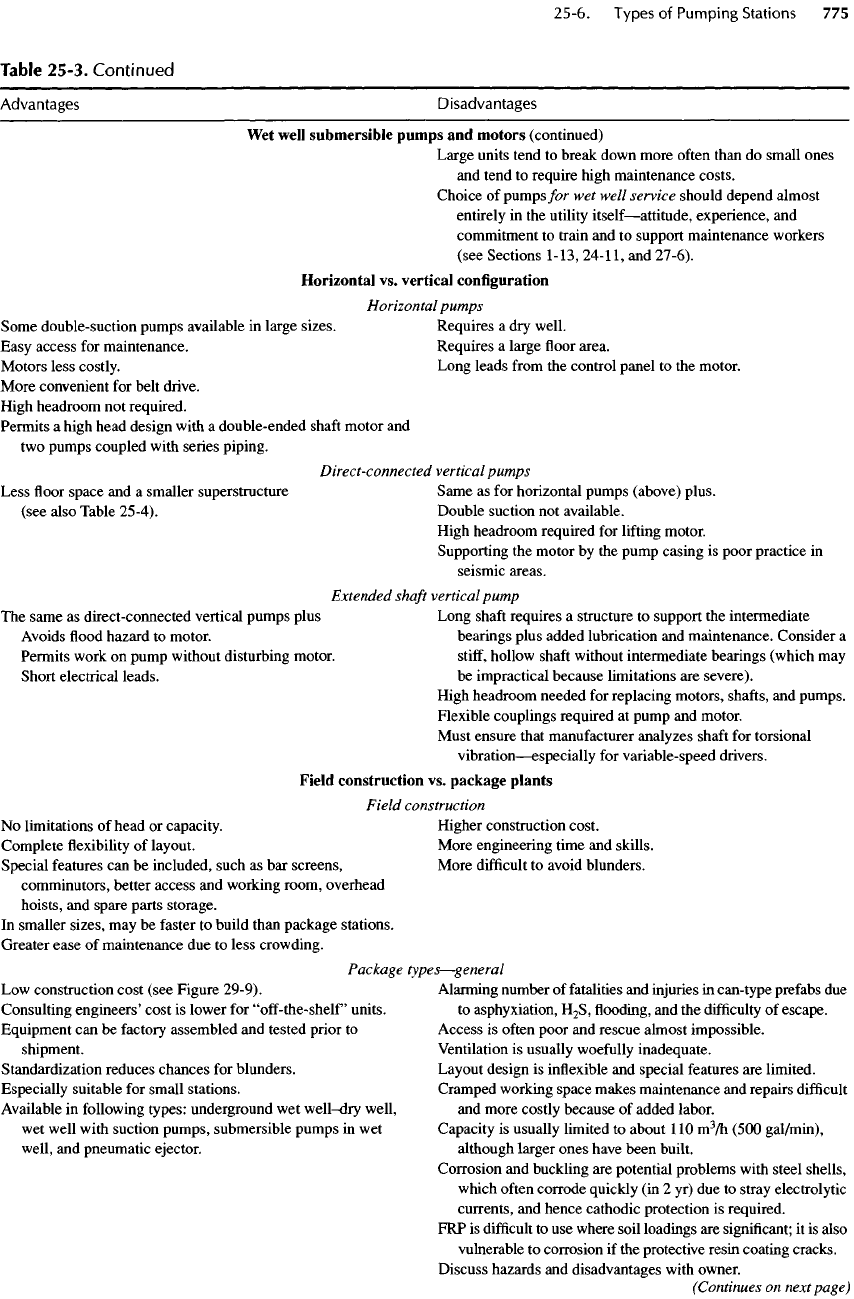
Table
25-3. Continued
Advantages
Disadvantages
Wet
well
submersible
pumps
and
motors
(continued)
Large units tend
to
break down more
often
than
do
small ones
and
tend
to
require high maintenance costs.
Choice
of
pumps
for wet
well service should depend almost
entirely
in the
utility
itself
—
attitude,
experience,
and
commitment
to
train
and to
support maintenance workers
(see
Sections
1-13,
24-11,
and
27-6).
Horizontal
vs.
vertical
configuration
Horizontal
pumps
Some double-suction pumps available
in
large
sizes.
Easy
access
for
maintenance.
Motors less costly.
More convenient
for
belt drive.
High
headroom
not
required.
Permits
a
high head design with
a
double-ended
shaft
motor
and
two
pumps coupled with
series
piping.
Requires
a dry
well.
Requires
a
large
floor
area.
Long leads
from
the
control panel
to the
motor.
Direct-connected
vertical pumps
Less
floor
space
and a
smaller superstructure
(see also Table
25-4).
Same
as for
horizontal pumps (above) plus.
Double suction
not
available.
High
headroom required
for
lifting
motor.
Supporting
the
motor
by the
pump casing
is
poor practice
in
seismic areas.
Extended
shaft
vertical pump
The
same
as
direct-connected vertical pumps plus
Avoids
flood
hazard
to
motor.
Permits work
on
pump without disturbing motor.
Short electrical leads.
Long
shaft
requires
a
structure
to
support
the
intermediate
bearings plus added lubrication
and
maintenance. Consider
a
stiff,
hollow
shaft
without intermediate bearings (which
may
be
impractical because limitations
are
severe).
High
headroom needed
for
replacing motors,
shafts,
and
pumps.
Flexible
couplings required
at
pump
and
motor.
Must ensure that manufacturer analyzes
shaft
for
torsional
vibration
—
especially
for
variable-speed drivers.
Field
construction
vs.
package
plants
Field
construction
No
limitations
of
head
or
capacity.
Complete
flexibility of
layout.
Special features
can be
included, such
as bar
screens,
comminutors,
better access
and
working room, overhead
hoists,
and
spare parts storage.
In
smaller sizes,
may be
faster
to
build than package stations.
Greater ease
of
maintenance
due to
less
crowding.
Higher construction
cost.
More engineering time
and
skills.
More
difficult
to
avoid blunders.
Package
types
—
general
Low
construction cost (see Figure
29-9).
Consulting
engineers' cost
is
lower
for
"off-the-shelf
units.
Equipment
can be
factory assembled
and
tested
prior
to
shipment.
Standardization reduces chances
for
blunders.
Especially suitable
for
small stations.
Available
in
following types: underground
wet
well-dry
well,
wet
well with suction pumps, submersible pumps
in wet
well,
and
pneumatic ejector.
Alarming
number
of
fatalities
and
injuries
in
can-type prefabs
due
to
asphyxiation,
H
2
S,
flooding, and the
difficulty
of
escape.
Access
is
often
poor
and
rescue almost impossible.
Ventilation
is
usually
woefully
inadequate.
Layout
design
is
inflexible
and
special features
are
limited.
Cramped working space makes maintenance
and
repairs
difficult
and
more costly because
of
added labor.
Capacity
is
usually limited
to
about
110
m
3
/h
(500
gal/min),
although larger
ones
have
been
built.
Corrosion
and
buckling
are
potential problems with steel shells,
which
often
corrode
quickly
(in 2 yr) due to
stray
electrolytic
currents,
and
hence cathodic protection
is
required.
FRP is
difficult
to use
where soil loadings
are
significant;
it is
also
vulnerable
to
corrosion
if the
protective resin coating cracks.
Discuss hazards
and
disadvantages
with
owner.
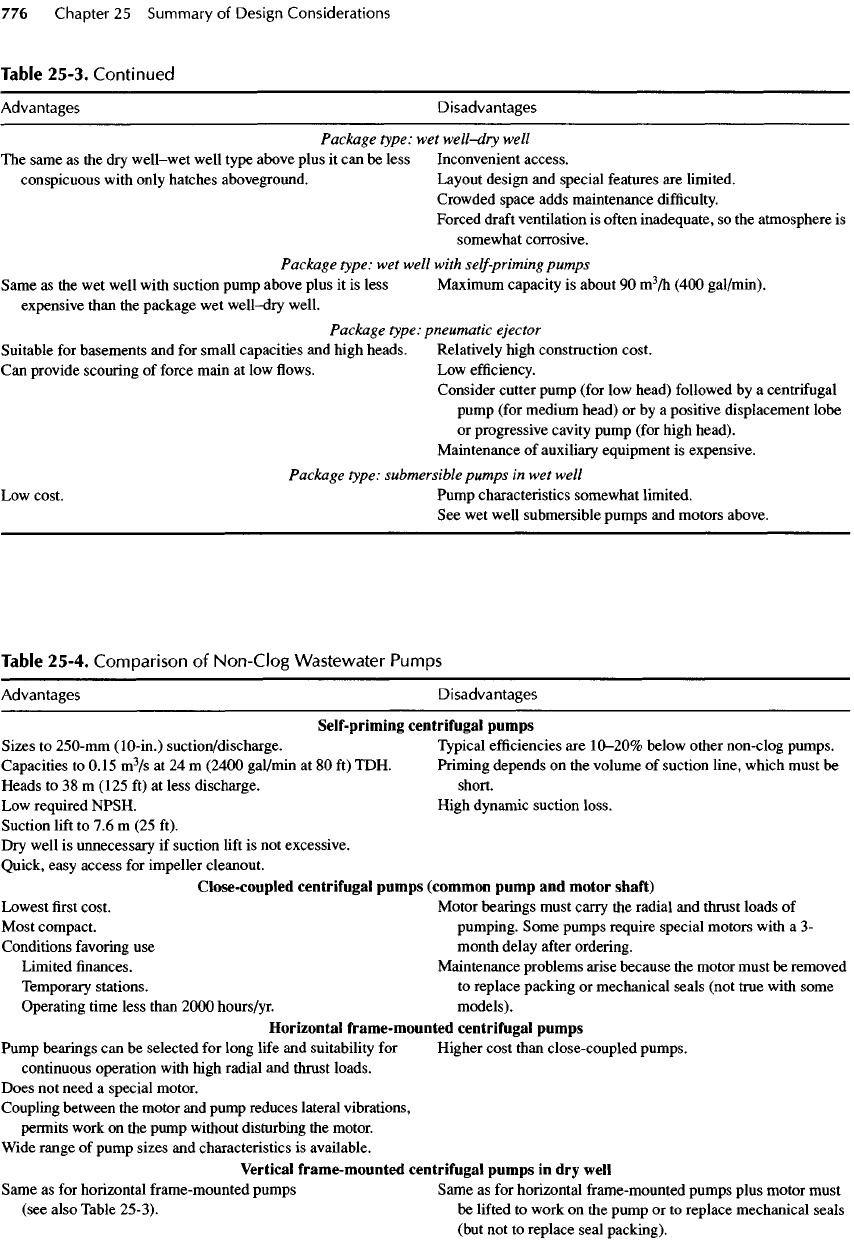
Table
25-3.
Continued
Advantages
Disadvantages
Package
type:
wet
well-dry
well
The
same
as the dry
well-wet
well type above plus
it can be
less
conspicuous
with
only hatches aboveground.
Inconvenient access.
Layout design
and
special features
are
limited.
Crowded space adds maintenance
difficulty.
Forced
draft
ventilation
is
often
inadequate,
so the
atmosphere
is
somewhat corrosive.
Package
type:
wet
well with
self-priming
pumps
Same
as the wet
well with suction pump above plus
it is
less
expensive than
the
package
wet
well-dry
well.
Maximum
capacity
is
about
90
m
3
/h
(400 gal/min).
Package
type:
pneumatic
ejector
Suitable
for
basements
and for
small capacities
and
high heads.
Can
provide scouring
of
force main
at low flows.
Relatively
high construction cost.
Low
efficiency.
Consider cutter pump (for
low
head) followed
by a
centrifugal
pump
(for medium head)
or by a
positive displacement lobe
or
progressive cavity pump (for high head).
Maintenance
of
auxiliary equipment
is
expensive.
Package
type:
submersible pumps
in wet
well
Low
cost. Pump
characteristics
somewhat
limited.
See wet
well submersible pumps
and
motors above.
Table
25-4.
Comparison
of
Non-Clog
Wastewater
Pumps
Advantages
Disadvantages
Self-priming centrifugal pumps
Sizes
to
250-mm
(10-in.)
suction/discharge.
Capacities
to
0.15
m
3
/s
at 24 m
(2400
gal/min
at 80 ft)
TDH.
Heads
to 38 m
(125
ft) at
less discharge.
Low
required NPSH.
Suction
lift
to 7.6 m (25
ft).
Dry
well
is
unnecessary
if
suction
lift
is not
excessive.
Quick, easy access
for
impeller
cleanout.
Typical
efficiencies
are
10-20%
below other non-clog pumps.
Priming depends
on the
volume
of
suction line, which must
be
short.
High dynamic suction
loss.
Close-coupled
centrifugal
pumps
(common
pump
and
motor
shaft)
Lowest
first
cost.
Most compact.
Conditions
favoring
use
Limited
finances.
Temporary stations.
Operating time less than
2000
hours/yr.
Motor bearings must carry
the
radial
and
thrust loads
of
pumping.
Some pumps require special motors with
a 3-
month delay
after
ordering.
Maintenance problems arise because
the
motor must
be
removed
to
replace packing
or
mechanical seals (not true with some
models).
Horizontal
frame-mounted centrifugal
pumps
Pump bearings
can be
selected
for
long
life
and
suitability
for
continuous
operation
with
high radial
and
thrust loads.
Does
not
need
a
special motor.
Coupling between
the
motor
and
pump reduces lateral vibrations,
permits
work
on the
pump
without
disturbing
the
motor.
Wide range
of
pump sizes
and
characteristics
is
available.
Higher cost than close-coupled pumps.
Vertical frame-mounted centrifugal pumps
in dry
well
Same
as for
horizontal frame-mounted pumps
(see also Table 25-3).
Same
as for
horizontal frame-mounted pumps plus motor must
be
lifted
to
work
on the
pump
or to
replace mechanical seals
(but
not to
replace seal packing).
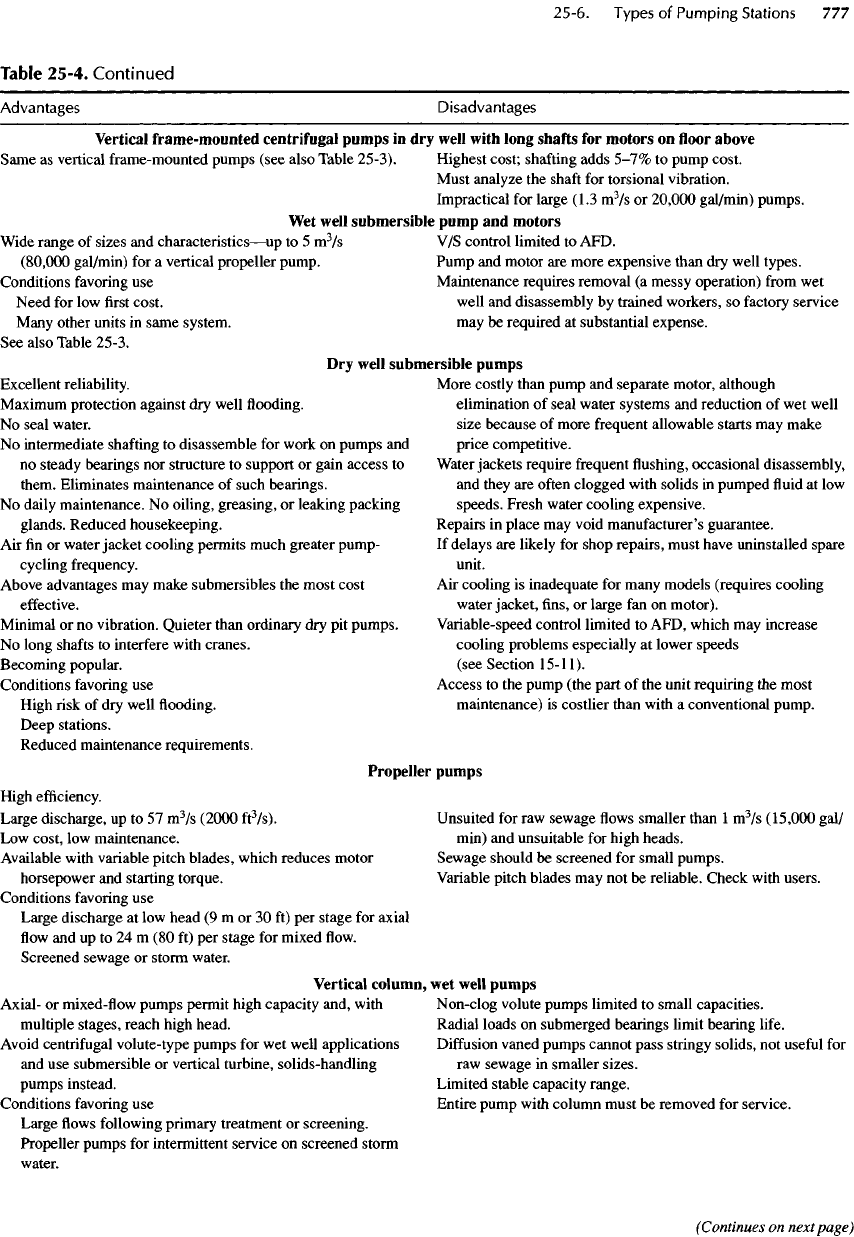
Table 25-4.
Continued
Advantages
Disadvantages
Vertical
frame-mounted
centrifugal
pumps
in dry
well
with
long
shafts
for
motors
on floor
above
Same
as
vertical frame-mounted pumps (see also Table 25-3).
Highest
cost;
shafting adds 5-7%
to
pump
cost.
Must
analyze
the
shaft
for
torsional vibration.
Impractical
for
large (1.3
m
3
/s
or
20,000
gal/min) pumps.
Wet
well
submersible
pump
and
motors
Wide
range
of
sizes
and
characteristics
—
up
to 5
m
3
/s
(80,000
gal/min)
for a
vertical
propeller
pump.
Conditions
favoring
use
Need
for low first
cost.
Many
other
units
in
same system.
See
also Table
25-3.
V/S
control limited
to
AFD.
Pump
and
motor
are
more expensive than
dry
well types.
Maintenance requires removal
(a
messy operation)
from
wet
well
and
disassembly
by
trained workers,
so
factory service
may
be
required
at
substantial expense.
Dry
well
submersible
pumps
Excellent reliability.
Maximum
protection against
dry
well
flooding.
No
seal water.
No
intermediate
shafting
to
disassemble
for
work
on
pumps
and
no
steady bearings
nor
structure
to
support
or
gain access
to
them. Eliminates maintenance
of
such bearings.
No
daily maintenance.
No
oiling, greasing,
or
leaking packing
glands. Reduced housekeeping.
Air
fin or
water jacket cooling permits much greater pump-
cycling
frequency.
Above
advantages
may
make submersibles
the
most cost
effective.
Minimal
or no
vibration. Quieter than ordinary
dry pit
pumps.
No
long
shafts
to
interfere with cranes.
Becoming popular.
Conditions
favoring
use
High
risk of dry
well
flooding.
Deep stations.
Reduced maintenance requirements.
More costly than pump
and
separate motor, although
elimination
of
seal water systems
and
reduction
of wet
well
size because
of
more frequent allowable starts
may
make
price competitive.
Water
jackets require
frequent
flushing,
occasional disassembly,
and
they
are
often
clogged with solids
in
pumped
fluid at low
speeds. Fresh water cooling expensive.
Repairs
in
place
may
void manufacturer's guarantee.
If
delays
are
likely
for
shop repairs, must have uninstalled spare
unit.
Air
cooling
is
inadequate
for
many models (requires cooling
water
jacket,
fins, or
large
fan on
motor).
Variable-speed control limited
to
AFD, which
may
increase
cooling problems especially
at
lower speeds
(see Section
15-11).
Access
to the
pump (the part
of the
unit requiring
the
most
maintenance)
is
costlier than with
a
conventional pump.
Propeller
pumps
High
efficiency.
Large discharge,
up to 57
m
3
/s
(2000
ft
3
/s).
Low
cost,
low
maintenance.
Available
with variable pitch blades, which reduces motor
horsepower
and
starting torque.
Conditions favoring
use
Large discharge
at low
head
(9 m or 30 ft) per
stage
for
axial
flow and up to 24 m (80 ft) per
stage
for
mixed
flow.
Screened sewage
or
storm water.
Unsuited
for raw
sewage
flows
smaller than
1
m
3
/s
(15,000
gal/
min)
and
unsuitable
for
high heads.
Sewage should
be
screened
for
small pumps.
Variable pitch blades
may not be
reliable. Check with users.
Vertical
column,
wet
well
pumps
Axial-
or
mixed-flow
pumps permit high capacity and, with
multiple
stages, reach high head.
Avoid
centrifugal
volute-type pumps
for wet
well applications
and
use
submersible
or
vertical turbine, solids-handling
pumps
instead.
Conditions
favoring
use
Large
flows
following primary treatment
or
screening.
Propeller pumps
for
intermittent service
on
screened storm
water.
Non-clog volute pumps limited
to
small capacities.
Radial loads
on
submerged bearings limit bearing
life.
Diffusion
vaned
pumps cannot pass stringy solids,
not
useful
for
raw
sewage
in
smaller
sizes.
Limited stable capacity range.
Entire pump
with
column must
be
removed
for
service.
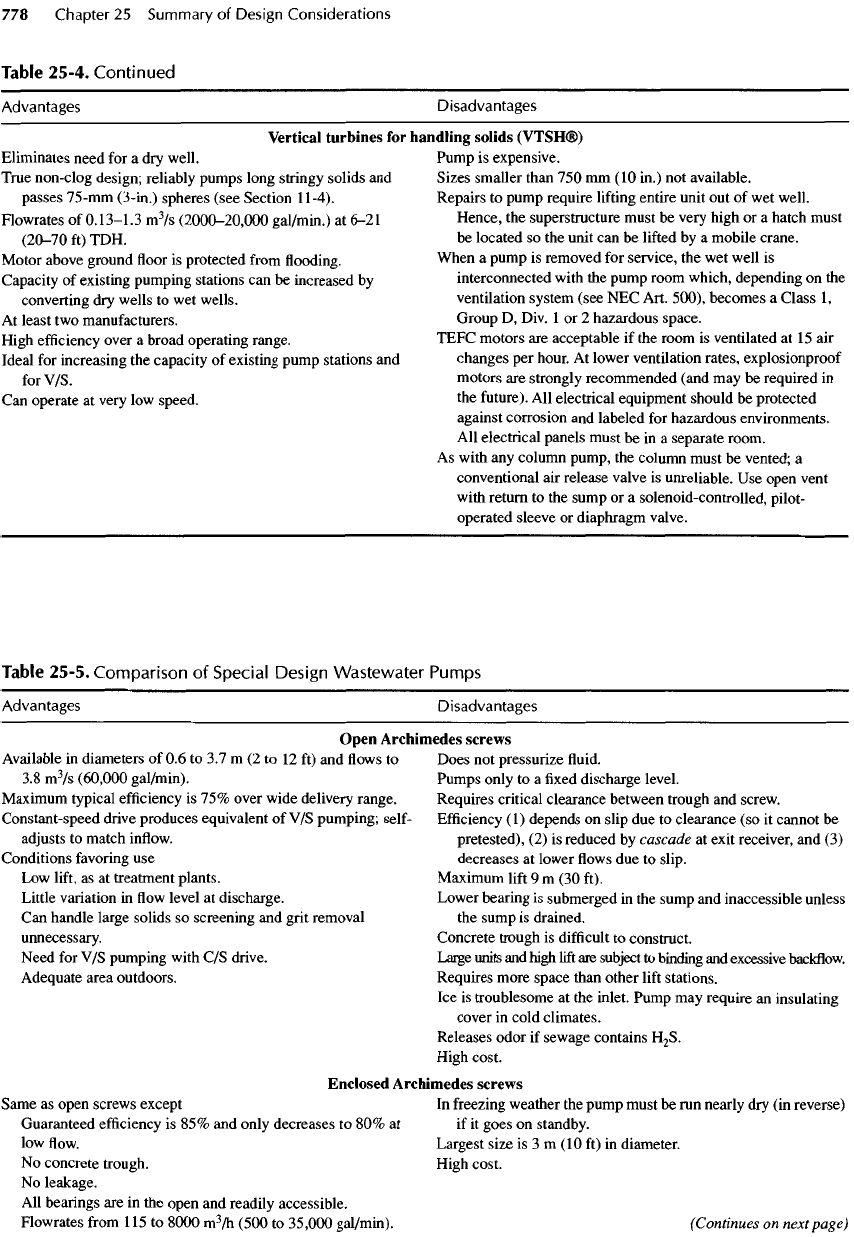
Available
in
diameters
of 0.6 to 3.7 m (2 to
12
ft) and flows to
3.8
m
3
/s
(60,000
gal/min).
Maximum
typical
efficiency
is 75%
over wide delivery range.
Constant-speed drive produces equivalent
of V/S
pumping;
self-
adjusts
to
match
inflow.
Conditions
favoring
use
Low
lift,
as at
treatment plants.
Little variation
in flow
level
at
discharge.
Can
handle large solids
so
screening
and
grit removal
unnecessary.
Need
for V/S
pumping with
C/S
drive.
Adequate
area outdoors.
Does
not
pressurize
fluid.
Pumps only
to a fixed
discharge level.
Requires critical clearance between trough
and
screw.
Efficiency
(1)
depends
on
slip
due to
clearance
(so it
cannot
be
pretested),
(2) is
reduced
by
cascade
at
exit receiver,
and (3)
decreases
at
lower
flows due to
slip.
Maximum
lift
9 m (30
ft).
Lower bearing
is
submerged
in the
sump
and
inaccessible unless
the
sump
is
drained.
Concrete trough
is
difficult
to
construct.
Large
units
and
high
lift
are
subject
to
binding
and
excessive
backflow.
Requires more space than other
lift
stations.
Ice is
troublesome
at the
inlet. Pump
may
require
an
insulating
cover
in
cold
climates.
Releases odor
if
sewage contains
H
2
S.
High
cost.
Enclosed
Archimedes
screws
Same
as
open screws except
Guaranteed
efficiency
is 85% and
only decreases
to 80% at
low flow.
No
concrete trough.
No
leakage.
All
bearings
are in the
open
and
readily accessible.
Flowrates
from
1
15
to
8000
m
3
/h
(500
to
35,000
gal/min).
In
freezing weather
the
pump must
be run
nearly
dry (in
reverse)
if
it
goes
on
standby.
Largest size
is 3 m (10 ft) in
diameter.
High cost.
(Continues
on
next
page)
Table 25-4.
Continued
Advantages
Disadvantages
Vertical
turbines
for
handling solids (VTSH®)
Eliminates need
for a dry
well. Pump
is
expensive.
True
non-clog design; reliably pumps long stringy solids
and
Sizes smaller than
750 mm (10
in.)
not
available.
passes
75-mm
(3-in.) spheres (see Section
11-4).
Repairs
to
pump require
lifting
entire unit
out of wet
well.
Flowrates
of
0.13-1.3
m
3
/s
(2000-20,000
gal/min.)
at
6-21
Hence,
the
superstructure must
be
very high
or a
hatch must
(20-70
ft)
TDH.
be
located
so the
unit
can be
lifted
by a
mobile crane.
Motor above ground
floor is
protected
from
flooding.
When
a
pump
is
removed
for
service,
the wet
well
is
Capacity
of
existing pumping stations
can be
increased
by
interconnected with
the
pump room which, depending
on the
converting
dry
wells
to wet
wells. ventilation system (see
NEC
Art. 500), becomes
a
Class
1,
At
least
two
manufacturers. Group
D,
Div.
1 or 2
hazardous space.
High
efficiency
over
a
broad operating range. TEFC motors
are
acceptable
if the
room
is
ventilated
at
15
air
Ideal
for
increasing
the
capacity
of
existing pump stations
and
changes
per
hour.
At
lower ventilation
rates,
explosionproof
for
V/S. motors
are
strongly recommended (and
may be
required
in
Can
operate
at
very
low
speed.
the
future).
All
electrical
equipment should
be
protected
against
corrosion
and
labeled
for
hazardous environments.
All
electrical
panels must
be in a
separate room.
As
with
any
column pump,
the
column must
be
vented;
a
conventional
air
release
valve
is
unreliable.
Use
open vent
with
return
to the
sump
or a
solenoid-controlled, pilot-
operated sleeve
or
diaphragm valve.
Table
25-5.
Comparison
of
Special
Design
Wastewater
Pumps
Advantages
Disadvantages
Open
Archimedes screws
